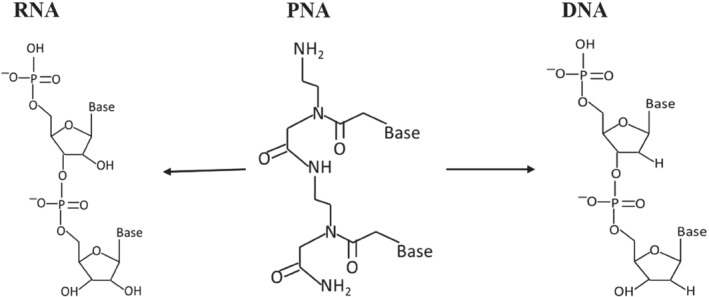PNA FISH Probe
Peptide nucleic acid (PNA) consists of a neutral polyamide backbone and its chemical configuration is the same as that of DNA molecules. This function allows PNA to hybridize with complementary DNA or RNA sequences. The FISH technology using non-standard DNA or RNA as probes and its combination with other technologies have promoted the application expansion and performance improvement of FISH. Since there is no electrostatic repulsion between the uncharged polyamide backbone and the charged DNA/RNA phosphodiester backbone, the PNA synthetic probe has excellent hybridization characteristics. This means that the thermal stability of the duplex is improved and allows the hybridization step to be completed at low salt concentrations. This situation destroys the stability of the rRNA secondary structure and improves access to the target sequence. In addition, PNA with a neutral charge can also diffuse well through bacterial membranes. Its synthetic properties lead to increased resistance to nucleases and proteases, making it widely used for microbial FISH analysis (pathogens).
 Fig 1. Structural comparison of PNA with RNA and DNA. (Singh K R B, et al. 2020)
Fig 1. Structural comparison of PNA with RNA and DNA. (Singh K R B, et al. 2020)
PNA Probe Design and Customization Services
PNA can be used for many of the same hybridization applications as natural or synthetic DNA probes but has additional advantages such as tighter binding and higher specificity. Our PNA probe customization service includes the customization of PNA probes that can be used to determine the length of telomeres and the customization of PNA probes in centromeric regions. At the same time, PAN-FISH has a wider range of applications due to many characteristics of PNA, especially for in-situ visualization of microorganisms. This service also provides customization of microbial rRNA sequence-specific PNA probes. We have an industry-leading synthetic probe service provider, which can provide independent design of probe sequences or assist customers in completing sequence design. Generally, we also accept customized services for customers to upload probe sequences by themselves. PNA is compatible with a variety of reporter molecules and fluorescent dyes. We provide a variety of fluorescent dyes (fluorescein, rhodamine, cyanine, Alex, etc.) for the labeling of probes. The detectable range of the dye covers the spectral range of the current general fluorescence microscope.
Advantages of PNA probes
- The combination of PNA probe and complementary DNA/RNA has higher affinity and higher specificity than traditional oligonucleotide probes;
- PNA probe is more stable (resistant to nuclease and protease);
- PNA probes can be hydrogenated at lower salt concentrations than DNA or RNA, resulting in higher stringency;
Creative Bioarray provides customized PNA probes that can be used for PNA-FISH analysis. Our customized PNA probes can target human telomeres and centromere regions. At the same time, it also provides customization of sequence-specific probes targeting microbial rRNA to facilitate in-situ visual analysis of microbial sequences. Our PNA-FISH probe uses industry-leading suppliers. You will benefit from our internally optimized design methods to provide you with cost-effective customized solutions for PNA probes. If you are interested in our PNA probe customization service, please contact us for customization. We look forward to cooperating with you in the near future.
References
- Singh K R B, Sridevi P, Singh R P. Potential applications of peptide nucleic acid in biomedical domain[J]. Engineering Reports, 2020, 2(9): e12238.
- Pellestor F, Paulasova P, Macek M, et al. The peptide nucleic acids: a new way for chromosomal investigation on isolated cells?[J]. Human Reproduction, 2004,
All products and services on this website are only suitable for non-medical purposes.


 Fig 1. Structural comparison of PNA with RNA and DNA. (Singh K R B, et al. 2020)
Fig 1. Structural comparison of PNA with RNA and DNA. (Singh K R B, et al. 2020)


